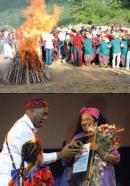- The Caribbean: a wave, a hug, a festival.
On the island of Guanahani, Bahamas, Christopher Columbus connected two worlds in the 15th Century. To the native inhabitants of the islands and the Iberian eyes of conquest, the Africans soon joined. Slavery began. Africa came with scarred back, but with a powerful edge in the throat. Asian and Arabs immigrants and from elsewhere added their brands at different stages in time.
Caribbean emerged as a space without wars and hatreds, which shows that coexistence of the plurality of beliefs and colors are possible in the same place.
The Caribbean goes beyond the purely geographical concept and becomes a spiritual mark. It always goes with his people in their successive Diasporas. It goes with its pain, its tastes, its knowledge.
Jesus Cos Causse defines the Caribbean as follows: "It is a part of the world with a different meaning that has nothing to do with drums and mulattos. It is a blood issue, and, above all, the history that defines us. That is the secret root that connects us beyond languages and races;it is the common history, the identity. "
The scholar Eduardo Rivero held its creation in a thought: "Eros was poured into the Caribbean. There is a special way of being Caribbean. Here the people dance when walking, dance when sitting ".
The Caribbean is the supreme moment of freedom trapped in the sculpture of Alberto Lescay in the mythical town of El Cobre, in the eastern part of the Island of Cuba.
Every July I am lucky to experiencethe Caribbean Festival in Santiago de Cuba, also called the Fiesta del Fuego. It started in the early 80’s as a descarga of the performing arts, and is already a showcase of the popular and traditional culture of the region.
The Fiesta del Fuego is blanket for poets, intellectuals and artists who do not believe in centers or peripheries. The culture isseen as the sap that runs through the veins, as the air that ignites the candles. This is a festival for people who love the sun; people who write, sing, dance, loves, taste and live.


























































